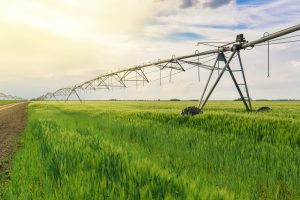From Seed to Grain: How to Grow Wheat for Optimal Yields
Wheat is one of the world’s most essential staple crops, providing essential carbohydrates and nutrients for a significant portion of the global population. To ensure a successful wheat production and maximize yields, it is crucial to implement best practices in wheat management throughout the growing season. This article will guide you through the key aspects of wheat management, including planting, fertilizing, irrigating, harvesting, and crop rotation.
PLANTING
Selecting the Right Wheat Variety:
Wheat varieties differ in their adaptability to various climates and soil types. For example, hard red winter wheat varieties thrive in the Great Plains region in the United States, accounting for over 70% of wheat production in this area. On the other hand, soft white wheat varieties are well-suited to the Pacific Northwest region in the United States due to their tolerance for the cooler, wetter climate prevalent in that area. Additionally, durum wheat, known for its high protein content and suitability for pasta production, finds its niche in arid regions where its drought tolerance allows for successful cultivation.
Timing
Proper timing of planting is essential for wheat’s growth. In the Northern Hemisphere, plant winter wheat in the fall, allowing it to establish strong roots before winter. Spring wheat, on the other hand, should be planted as soon as soil temperatures reach around 50°F (10°C) in the spring.
For the northern hemisphere: plant winter wheat from late September to early November. Plant spring wheat from late March to early May.
Sowing
High-quality, certified seeds are essential for uniform germination and disease resistance. Utilizing certified seeds offers tangible benefits, such as increased yields—often by 10-15% compared to non-certified seed.
Seeding rate: The recommended seeding rate for winter wheat ranges from 1.2 to 2.2 million seeds per acre, depending on factors like soil quality and local conditions.
Typically, wheat should be planted at a depth of 1 to 2 inches (2.5 to 5 centimeters) for optimal germination.
FERTILIZATION
Regular soil testing is essential to determine nutrient levels and pH. Taking soil samples from multiple locations in the field is important, as soil nutrient levels can vary widely across fields.
Nitrogen Management
Nitrogen is a vital nutrient for wheat growth. The total nitrogen requirement for wheat can vary, but it’s often in the range of 60 to 120 pounds per acre. Apply nitrogen fertilizer in split applications, with a portion applied at planting and the rest during the tillering stage. This helps avoid nutrient losses and can significantly enhance nitrogen use efficiency.
Phosphorus and potassium
Maintain adequate levels of phosphorus and potassium in the soil to support root development and overall plant health. Soil tests will guide you in adjusting these nutrients as needed.
Adequate levels of phosphorus and potassium are typically maintained at 15-30 pounds per acre of P2O5 and K2O, respectively.
Micronutrients
Although required in smaller quantities, micronutrients are required for wheat production. Among the essential micronutrients, iron (Fe), manganese (Mn), zinc (Zn), and copper (Cu) stand out as vital components of enzymes that drive photosynthesis, improve nutrient uptake efficiency, and enhance overall plant health.
These micronutrients play pivotal roles in increasing wheat’s resistance to diseases and pests, improving grain quality by influencing protein content, and supporting stress tolerance mechanisms.
IRRIGATION
Efficient water management is crucial for wheat production. Adequate moisture is particularly critical during the grain-filling stage. Monitor soil moisture regularly and maintain soil moisture levels between 50-70% of field capacity.
Wheat typically requires about 15-25 inches (380 – 635 mm) of water throughout the growing season, including both precipitation and irrigation.
Overwatering can lead to disease issues and reduce yield. Utilize evapotranspiration data to schedule irrigations effectively. On the other hand, sever water stress can result in yield losses of up to 50%,
To calculate water requirements for wheat, begin by determining the crop coefficient (Kc) based on local factors like climate and wheat variety. Collect weather data to calculate reference evapotranspiration (ETo), reflecting water loss under local weather conditions. Then, adjust ETo using the Kc values for each wheat growth stage to estimate crop evapotranspiration (ETc).
The approximate Kc values for wheat at different growth stages are:
Initial Stage (Emergence to Vegetative Growth): Kc: 0.2 to 0.4
Crop Development (Tillering to Jointing): Kc: 0.5 to 0.7
Mid-Season (Heading to Flowering): Kc: 0.8 to 1.0
Late-Season (Milk Stage to Maturity): Kc: 0.6 to 0.8
PEST AND DISEASE MANAGEMENT
Wheat production faces challenges from various pests and diseases, including aphids, Hessian flies, rusts (stripe, leaf, and stem rust), powdery mildew, and fusarium head blight (scab).
These threats can impact yields and grain quality significantly. Implementing integrated pest and disease management practices, such as crop rotation, planting resistant varieties, and regular field monitoring, is crucial for safeguarding wheat crops against these potential threats.
CROP ROTATION
Practice crop rotation to break pest and disease cycles, improve soil fertility, and maintain long-term wheat productivity. Sustainable crop rotation can lead to cost savings and environmental benefits by reducing chemical inputs.
Choose crops for rotation that are well-suited to your local conditions and market demands. A common crop rotation cycle for wheat might include wheat, followed by a broadleaf crop like soybeans or canola, and then a year of rest with a cover crop or fallow ground.
HARVESTING
Harvest wheat when it reaches the optimum maturity stage. This stage is typically indicated by the grain moisture content, which should be around 13-15% for most wheat varieties. Harvesting too early or too late can result in reduced quality and yield.
Wheat yields vary greatly by region and management practices, but an average yield might range from 40 to 70 bushels per acre.
Combine Settings: Set your combine properly to minimize grain damage and losses during harvesting. Adjust settings for header height, ground speed, and rotor or cylinder speed according to crop conditions.
GRAIN STORAGE
Store harvested wheat in clean, dry bins with adequate aeration to prevent moisture buildup, mold and spoilage. Regularly monitor stored grain for temperature and moisture content.
SUMMARY
To summarize, successful wheat management involves a combination of knowledge, planning, and diligent execution of best practices throughout the growing season. By selecting the right wheat variety, providing adequate nutrients and water, harvesting at the right time, and practicing crop rotation, you can optimize your wheat yields, improve soil health, and ensure the long-term sustainability of your wheat farming operation. Stay informed about the latest advancements in wheat management to continuously improve your practices and adapt to changing agricultural trends.







